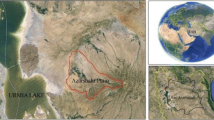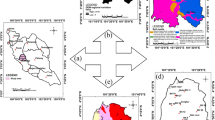Abstract
Mapping vulnerability to Saltwater Intrusion (SWI) in coastal aquifers is studied in this paper using the GALDIT framework but with a novelty of transforming the concept of vulnerability indexing to risk indexing. GALDIT is the acronym of 6 data layers, which are put consensually together to invoke a sense of vulnerability to the intrusion of saltwater against aquifers with freshwater. It is a scoring system of prescribed rates to account for local variations; and prescribed weights to account for relative importance of each data layer but these suffer from subjectivity. Another novelty of the paper is to use fuzzy logic to learn rate values and catastrophe theory to learn weight values and these together are implemented as a scheme and hence Fuzzy-Catastrophe Scheme (FCS). The GALDIT data layers are divided into two groups of Passive Vulnerability Indices (PVI) and Active Vulnerability Indices (AVI), where their sum is Total Vulnerability Index (TVI) and equivalent to GALDIT. Two additional data layers (Pumping and Water table decline) are also introduced to serve as Risk Actuation Index (RAI). The product of TVI and RAI yields Risk Indices. The paper applies these new concepts to a study area, subject to groundwater decline and a possible saltwater intrusion problem. The results provide a proof-of-concept for PVI, AVI, RAI and RI by studying their correlation with groundwater quality samples using the fraction of saltwater (fsea), Groundwater Quality Indices (GQI) and Piper diagram. Significant correlations between the appropriate values are found and these provide a new insight for the study area.





Similar content being viewed by others
References
Appelo CAJ, Postma D (2004) Geochemistry, groundwater and pollution. CRC press
Chachadi AG, Lobo-Ferreira JP (2001) Sea water intrusion vulnerability mapping of aquifers using GALDIT method. Coastin—A Coast Policy Res Newsl 4:7–9
Cheng CH, Liu YH, Lin Y (1996) Evaluating a weapon system using catastrophe series based on fuzzy scales. In: Soft computing in intelligent systems and information processing. Proceedings of the 1996 Asian fuzzy systems symposium. IEEE, pp 212–217
Docheshmeh Gorgij A, Asghari Moghaddam A (2016) Vulnerability assessment of saltwater intrusion using simplified GAPDIT method: a case study of Azarshahr plain aquifer, East Azerbaijan, Iran. Arab J Geosci 9:106. https://doi.org/10.1007/s12517-015-2200-1
Emberger L (1930) Sur Une formule applicable en géographie botanique. Cah Herb Seanc Acad Sci 191:389–390
Ferguson G, Gleeson T (2012) Vulnerability of coastal aquifers to groundwater use and climate change. Nat Clim Chang 2:342–345. https://doi.org/10.1038/nclimate1413
Jenks GF (1967) The data model concept in statistical mapping. Int Yearb Cartogr 7:186–190
Kazakis N, Spiliotis M, Voudouris K, Pliakas FK, Papadopoulos B (2018) A fuzzy multicriteria categorization of the GALDIT method to assess seawater intrusion vulnerability of coastal aquifers. Sci Total Environ 621:524–534. https://doi.org/10.1016/j.scitotenv.2017.11.235
Kazakis N, Busico G, Colombani N, Mastrocicco M, Pavlou A, Voudouris K (2019) GALDIT-SUSI a modified method to account for surface water bodies in the assessment of aquifer vulnerability to seawater intrusion. J Environ Manag 235:257–265. https://doi.org/10.1016/j.jenvman.2019.01.069
Kelly D (2005) Seawater intrusion topic paper (final). Island County: WRIA, vol 6, pp 1–30
Ketabchi H, Mahmoodzadeh D, Ataie-Ashtiani B, Simmons CT (2016) Sea-level rise impacts on seawater intrusion in coastal aquifers: review and integration. J Hydrol 535:235–255. https://doi.org/10.1016/j.jhydrol.2016.01.083
Khatibi R (2011) Evolutionary systemic modelling of practices on flood risk. J Hydrol 401:36–52. https://doi.org/10.1016/j.jhydrol.2011.02.006
Klassen J, Allen DM (2017) Assessing the risk of saltwater intrusion in coastal aquifers. J Hydrol 551:730–745. https://doi.org/10.1016/j.jhydrol.2017.02.044
Lobo-Ferreira JP, Chachadi AG, Diamantino C, Henriques MJ (2005) Assessing aquifer vulnerability to seawater intrusion using GALDIT method: part 1—application to the Portuguese aquifer of Monte Gordo, the fourth inter-Celtic colloquium on hydrology and management of water resources, Guimaraes, Portugal, 12
Luoma S, Okkonen J, Korkka-Niemi K (2017) Comparison of the AVI, modified SINTACS and GALDIT vulnerability methods under future climate-change scenarios for a shallow low-lying coastal aquifer in southern Finland. Hydrogeol J 25:203–222. https://doi.org/10.1007/s10040-016-1471-
Machiwal D, Cloutier V, Güler C, Kazakis N (2018) A review of GIS-integrated statistical techniques for groundwater quality evaluation and protection. Environ Earth Sci 77:681. https://doi.org/10.1007/s12665-018-7872-x
Michael HA, Mulligan AE, Harvey CF (2005) Seasonal oscillations in water exchange between aquifers and the coastal ocean. Nature 436:1145–1148. https://doi.org/10.1038/nature03935
Michael HA, Post VE, Wilson AM, Werner AD (2017) Science, society, and the coastal groundwater squeeze. Water Resour Res 53:2610–2617. https://doi.org/10.1002/2017WR020851
Morgan LK, Werner AD (2014) Seawater intrusion vulnerability indicators for freshwater lenses in strip islands. J Hydrol 508:322–327. https://doi.org/10.1016/j.jhydrol.2013.11.002
Nadiri AA, Fijani E, Tsai FTC, Asghari Moghaddam A (2013) Supervised committee machine with artificial intelligence for prediction of fluoride concentration. J Hydroinform 15 (4):1474-1490. https://doi.org/10.2166/hydro.2013.008
Nadiri AA, Sedghi Z, Khatibi R, Sadeghfam S (2018) Mapping specific vulnerability of multiple confined and unconfined aquifers by using artificial intelligence to learn from multiple DRASTIC frameworks. J Environ Manag 227:415–428. https://doi.org/10.1016/j.jenvman.2018.08.019
NASA (2012) https://www.nasa.gov/sites/default/files/trl.png
Parizi E, Hosseini SM, Ataie-Ashtiani B, Simmons CT (2019) Vulnerability mapping of coastal aquifers to seawater intrusion: review, development and application. J Hydrol 570:555–573. https://doi.org/10.1016/j.jhydrol.2018.12.021
Piper AM (1944) Trans Am Geophys Union 25:914–923
Sadeghfam S, Hassanzadeh Y, Nadiri AA, Khatibi R (2016a) Mapping groundwater potential field using catastrophe fuzzy membership functions and Jenks optimization method: a case study of Maragheh-Bonab plain. Iran Environ Earth Sci 75:545. https://doi.org/10.1007/s12665-015-5107-y
Sadeghfam S, Hassanzadeh Y, Nadiri AA, Zarghami M (2016b) Localization of groundwater vulnerability assessment using catastrophe theory. Water Resour Manag 30:4585–4601. https://doi.org/10.1007/s11269-016-1440-5
Sadeghfam S, Hassanzadeh Y, Khatibi R, Moazamnia M, Nadiri AA (2018) Introducing a risk aggregation rationale for mapping risks to aquifers from point-and diffuse-sources–proof-of-concept using contamination data from industrial lagoons. Environ Impact Assess Rev 72:88–98. https://doi.org/10.1016/j.eiar.2018.05.008
Seenipandi K, Nainarpandian C, Kandathil RK, Sellamuthu S (2019) Seawater intrusion vulnerability in the coastal aquifers of southern India—an appraisal of the GALDIT model, parameters’ sensitivity, and hydrochemical indicators. Environ Sci Pollut Res Int 26:9755–9784. https://doi.org/10.1007/s11356-019-04401-0
Simpson MW, Allen DM, Journeay MM (2014) Assessing risk to groundwater quality using an integrated risk framework. Environ Earth Sci 71(11):4939–4956
Small C, Nicholls RJ (2003) A global analysis of human settlement in coastal zones. J Coastal Res 19:584–599. https://doi.org/10.1007/s12665-013-2886-x
Taylor RG, Scanlon B, Döll P, Rodell M, Van Beek R, Wada Y et al (2013) Ground water and climate change. Nat Clim Chang 3:322–329. https://doi.org/10.1038/nclimate1744
Tomaszkiewicz M, Najm MA, El-Fadel M (2014) Development of a groundwater quality index for seawater intrusion in coastal aquifers. Environ Model Softw 57:13–26. https://doi.org/10.1016/j.envsoft.2014.03.010
Wang W, Liu S, Zhang S, Chen J (2011) Assessment of a model of pollution disaster in near-shore coastal waters based on catastrophe theory. Ecol Model 222:307–312. https://doi.org/10.1016/j.ecolmodel.2010.09.007
Werner AD, Bakker M, Post VE, Vandenbohede A, Lu C, Ataie-Ashtiani B et al (2013) Seawater intrusion processes, investigation and management: recent advances and future challenges. Adv Water Resour 51:3–26. https://doi.org/10.1016/j.advwatres.2012.03.004
West Azerbaijan Water Authority (2015), provided the data through private communications.
Wisner B, Blaikie P, Cannon T, Davis I (2004) At risk: natural hazards, people's vulnerability and disasters. Routledge, London
Acknowledgements
The authors would like to Thank Dr. Barret Kurylyk for a review of the draft version of the paper.
Author information
Authors and Affiliations
Corresponding author
Ethics declarations
We ensure that the current paper incorporates the following statements:
• Disclosure of potential conflicts of interest.
• Research involving Human Participants and/or Animals.
• Informed consent.
Additional information
Publisher’s Note
Springer Nature remains neutral with regard to jurisdictional claims in published maps and institutional affiliations.
Rights and permissions
About this article
Cite this article
Sadeghfam, S., Khatibi, R., Daneshfaraz, R. et al. Transforming Vulnerability Indexing for Saltwater Intrusion into Risk Indexing through a Fuzzy Catastrophe Scheme. Water Resour Manage 34, 175–194 (2020). https://doi.org/10.1007/s11269-019-02433-2
Received:
Accepted:
Published:
Issue Date:
DOI: https://doi.org/10.1007/s11269-019-02433-2




